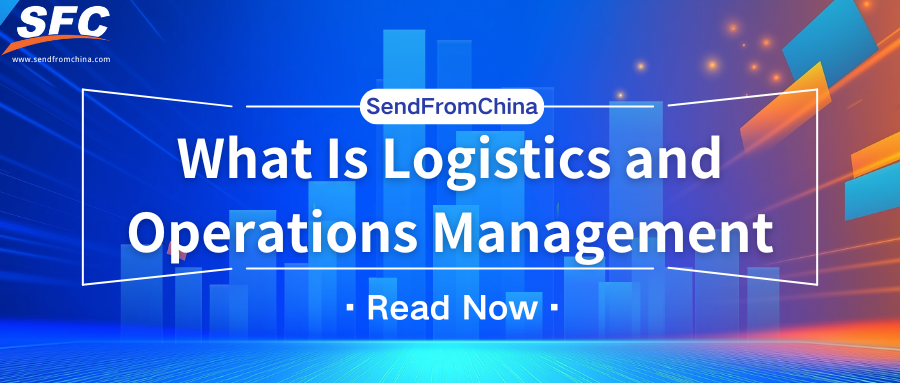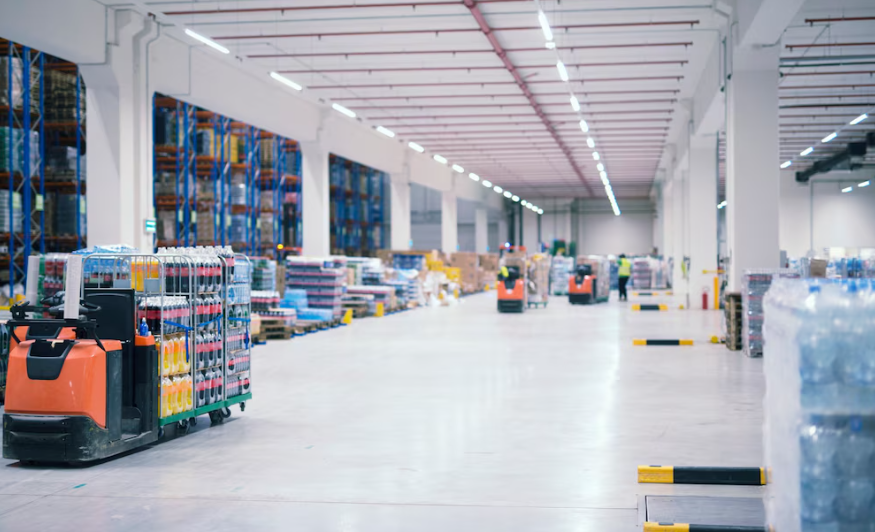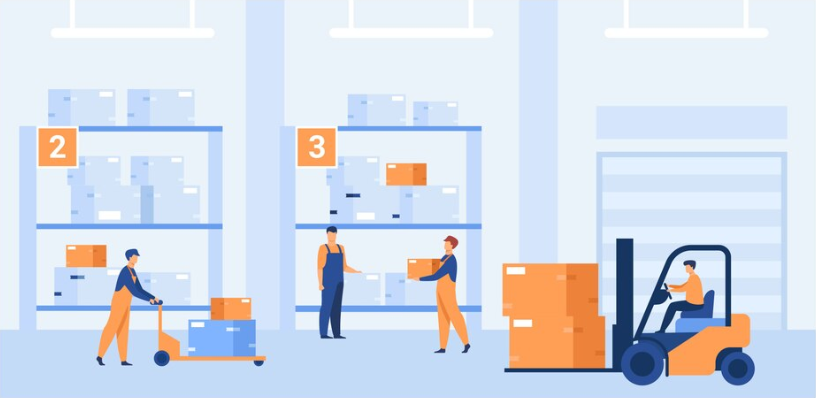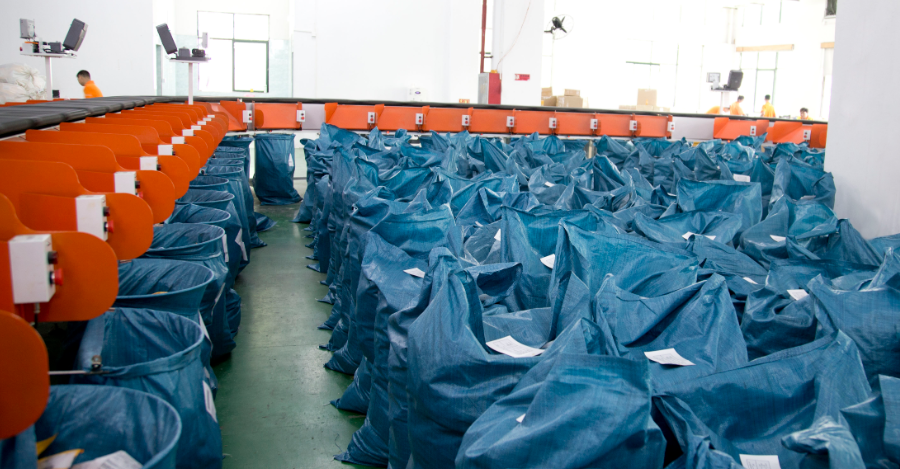Table of Contents
What Is Logistics and Operations Management? Key Trends & How to Improve
Time: Jun 20,2025 Author: SFC Source: www.sendfromchina.com
Logistics and operations management is more than moving goods—it’s the engine behind cost savings, customer satisfaction, and supply chain resilience. From AI-powered forecasting to green logistics and last-mile innovation, businesses must adapt quickly to stay competitive.This guide explores what logistics operations really mean, why they matter, the latest trends, and practical tips to streamline your process—plus how partners like SendFromChina can give you a global edge.

1. What Is Logistics Operations?
At its core, logistics operations oversee the planning, execution, and coordination of moving goods and services from origin to destination. It includes procurement, transportation, warehousing, inventory management, order processing, and reverse logistics (handling returns).Think of logistics as the bloodstream of any business – it ensures materials flow into production lines and finished goods reach customers. Effective logistics teams control timing, cost, and resource usage, while adapting to variable demand and unexpected disruptions.
2. Why Logistics and Operations Management Matter?
Strong logistics and operations management is the foundation of:
Major Cost Centers with Significant Impact
- Logistics isn’t just an operational detail—it’s a strategic cost center. In the U.S., logistics expenditures hit $1.64 trillion in 2018, equating to roughly 8% of GDP, with individual companies allocating over 10% of revenues to logistics-related activities.- For industrial suppliers, logistics costs can range from 13.2% down to as low as 7.9%, with top performers achieving a 40% cost reduction through process optimization.
- Ultimately, even modest improvements—such as optimizing inventory by 25% with proper management—can yield massive financial gains like boosted cash flow and sharper margins.
Customer Expectations Drive Logistics Excellence
- Nearly 70% of consumers expect same-day delivery, and last-mile delivery can absorb more than 50% of total shipping costs.- Efficient logistics—characterized by reliable real-time tracking and swift fulfillment—translates into superior customer experiences, driving repeat purchases, positive reviews, and improved brand loyalty.
Resilience in the Face of Disruption
- In 2025, the global logistics ecosystem is increasingly fragile—subject to geopolitical tensions, extreme weather, cyberattacks, and pandemic aftershocks.- Today’s leading companies prioritize resilience over short-term savings, with platforms like Deloitte reporting that 79% of businesses value resilience more than cost.
- The cost of disruption can reach $1.5 million per day, underscoring the urgency of investing in robust logistics and contingency planning.
Visibility Equals Agility and Efficiency
- Only 6% of companies claim to have full supply chain visibility—this gap leaves the rest susceptible to errors, delays, and wasted resources.- Achieving transparent, end-to-end logistics helps teams anticipate bottlenecks, adjust routes on the fly, and reduce lead times by 40% or more.
Data-Driven Decision-Making
- The shift to data-centric logistics is no longer optional—it’s essential. Real-time tracking, predictive analytics, and digital twins provide actionable insights that directly drive operational efficiency.- Companies using AI and big-data analytics forecast demand more accurately, optimize routes, and dynamically allocate resources—reducing stockouts, cutting fuel usage, and improving on-time delivery metrics.
3. Processes of Logistics and Operations Management
Logistics and operations management consists of a series of interlinked processes—ranging from sourcing raw materials to handling returns—all orchestrated to ensure the efficient flow of goods, information, and resources across the supply chain. Below, we break down each essential process and explore how they interconnect:
Planning, Forecasting & Sales & Operations Planning (S&OP)
- Demand Forecasting uses historical sales data and market indicators to predict future needs, helping avoid costly stockouts or excess inventory—up to 40% of sunk costs can be saved by accurate forecasting.- S&OP brings cross-functional alignment across sales, production, finance, and logistics. It merges demand and supply planning into coherent monthly cycles covering 12–18 months to stabilize operations and improve agility.
Procurement & Supplier Coordination
- This process involves strategically sourcing raw materials, negotiating contracts, and qualifying suppliers to ensure “right quality, quantity, time, price, and source”—the CIPS “Five Rights” framework.- Procurement logistics guarantees that goods arrive in good condition and precisely when needed, minimizing disruptions and cutting procurement-related costs by an average of 6–7% per year.
Inbound Logistics & Receiving
- Inbound logistics covers the transport, customs, and unloading processes that bring materials into warehouses or manufacturing sites.- Receiving procedures include detailed inspection and verification against purchase orders to prevent errors that ripple through the chain—this step ensures accurate inventory and storage placement.
Warehousing & Material Handling
- Warehousing involves discovery, sorting, storage, and retrieval. Modern setups use WMS (Warehouse Management Systems) to track item locations and stock levels in real-time.- Warehouse Execution Systems (WES) layer in real-time orchestration—managing pick-pack cycles, directing staff and machines, and offering predictive alerts for equipment issues.
Inventory Control & Optimization
- Proper inventory control rules (e.g., FIFO/LIFO) prevent spoilage and stock imbalance. Errors are costly: overstock ties up capital, while stockouts damage reputation and sales.- Techniques like ABC classification and demand-driven replenishment keep inventory lean yet responsive.
Transportation Management & Outbound Logistics
- TMS (Transportation Management Systems) optimize shipment planning—suggesting carrier options, routing, load tendering, costing, and tracking integrations with ERP/WMS.- Efficient outbound logistics connects production to delivery—covering distribution, consolidation, and last-mile fulfillment via optimized routing and real-time tracking.
Order Fulfillment & Customer Communication
- Fulfillment spans order receipt, picking, packing, and shipping. Efficient flows ensure fast, accurate delivery and use automation where feasible.- Proactive customer updates and tracking links reduce anxieties and increase satisfaction—especially critical in e-commerce and B2C channels.
Reverse Logistics & Returns Management
- Reverse logistics handles returns, exchanges, recycling, and repairs. A smooth reverse flow reintegrates value and reduces waste—or helps with compliance and sustainability reporting.- Processing returns efficiently cuts costs, sustains loyalty, and supports ESG initiatives.
Visibility & Performance Measurement
- Real-time tracking via GPS, RFID, and barcode scanning enhances speed and accuracy. Only ~6% of companies report full supply chain visibility.- KPIs—such as on-time delivery rate, fill rate, cost per order, and inventory days of supply—matter most when monitored in a dashboard-driven logistics control tower.
4. 2025’s Core Trends in Logistics
The logistics sector is rapidly advancing in 2025, with several key developments taking center stage:
Automation, Robotics & AI
Warehouse robotics (cobots for picking, packaging, sorting) are becoming mainstream. Their adoption results in faster throughput, fewer errors, and reduced labor fatigue. Companies like Amazon continue to blend advanced robotics with human oversight to optimize operations.Enhanced Visibility & Control Towers
Traditional tools like RFID and TMS remain useful, but AI-driven platforms now offer configurable “control tower” views—highlighting gaps, predicting delays, and suggesting corrective actions.Sustainable & Green Logistics
Environmental regulation has ratcheted up – for example, the EU Emissions Trading System and low-sulfur mandates in shipping. Logistics operations now favor greener packaging, cleaner fuel, optimized loading, and reverse logistics to reduce waste.Resilience Through Digitization
Post-COVID disruptions exposed vulnerabilities. Companies are building resilience with digitized workflows, real-time analytics, and flexible supply chain design.Rise of 3PL, 4PL & Logistics-as-a-Service (LaaS)
Outsourcing is trending upward. Enterprises are turning to 3PL/4PL and cloud-based logistics platforms for scalability, tech integration, and CAPEX mitigation.Internet of Things (IoT) & Digital Twins
IoT sensors feed WMS/TMS with real-time data on cargo conditions and vehicle health. Digital-twin models enable scenario simulations like port closures or surge demand.Blockchain & Supply Chain Transparency
Blockchain-backed digital twins and immutable ledgers foster traceability and compliance throughout the supply chain . LLM-based analytics further enhance insights into these data streams.Last‑Mile Innovation
Autonomous vehicles, drones, and AI-driven route optimization (Uber Freight, etc.) are improving last-mile delivery, cutting empty routes, fuel usage, and transit times.Cybersecurity & Digital Risk
As systems scale and digitize, so does cyber vulnerability. Protecting TMS/WMS and data exchanges through encryption, access control, and threat detection is now essential.5. 7 Small Tips to Optimize Your Logistics Operations
Even modest adjustments can yield significant improvements in efficiency, cost savings, and customer satisfaction. Here are seven practical strategies you can implement today:
Identify Weaknesses & Prioritize Quick Wins
Start by mapping your current logistics flow—inventory management, picking, packing, shipping, returns, etc.—and highlight bottlenecks.- Inventory pains? Maybe reorder points and safety stock need adjustment.
- Delays in shipping? You might need route optimization or stronger carrier contracts.
Separate improvements into short-term “quick wins” and longer-term initiatives.
Track KPIs & Use Data to Diagnose
Define metrics that matter—on-time delivery rate, fill rate, cost per order, average picking time.- Visual dashboards give instant insight into underperformance.
- Historical analysis highlights trends and recurring issues.
Invest in Scalable Tech
You don’t need a massive budget for digitization:- Cloud-based inventory systems, route-planning tools, handheld scanners, or basic TMS bring immediate returns.
- For small businesses, desktop WMS and integrated scanning tools boost accuracy and throughput.
Consolidate Shipments & Optimize Routes
- Combine multiple small orders into consolidated loads to slash shipping costs and cut delivery numbers.- Leverage route-optimization tools or simple batch planning to prevent inefficient truck paths.
Improve Warehouse Layout & Labeling
- A clean, zone-based layout—using lean principles like 5S—makes picking and packing faster and safer.- Clear labeling ensures items and shelves are easy to locate and reduces human errors.
Enhance Communication & Customer Experience
- Keep customers informed with order status updates, real-time tracking links, and proactive alerts.- These interactions raise trust and reduce inbound queries.
Build Strong Supplier & Logistics Partnerships
- Tighten coordination with suppliers: set review cadence, align delivery windows, and share demand plans to reduce stockouts.- Explore opportunities to work with 3PL providers for flexible, tech-enabled services—especially useful during scaling or diversifying carrier mix.
6. How SendFromChina Improve Your Logistics and Operations Management
SendFromChina (SFC), a tech‑driven China-based fulfillment provider founded in 2007, offers a compelling cross-border logistics solution.
Key Highlights
- Global coverage – Over 220 covered countries and dedicated routes to North America, Latin America, and Europe.- Omni‑service model – From warehousing in Shenzhen and the U.S., to picking, packing, labeling, and kitting.
- High throughput – Handles 300–500K parcels daily and supports 100K+ registered users .
- Tech‐enabled transparency – Tech platforms featuring real-time tracking, TMS/WMS integration, quick quotes, automation, and CRM capabilities.
- Custom focus – Services tailored for e‑commerce and small to midsize brands: free 30‑day storage, customized packaging, and total-project pricing.
- Mixed reviews – Many businesses praise clear communication, fast shipping, and responsive support. However, some cite long transit times and occasional delays .
Using SendFromChina helps you de-risk international logistics, cut complexity, and scale rapidly, leveraging their global network and tech stack.
7. Conclusion
Logistics in 2025 is a data-driven, sustainable, and customer-centric engine. Companies that embrace AI, green practices, and strategic partnerships (like SendFromChina) will dominate markets through unmatched efficiency and resilience. Start small—audit one process, implement one tech tool—and scale optimization relentlessly.8. FAQs
Q1: What’s the difference between logistics and supply chain management?
A: Logistics covers the movement and storage of goods. Supply chain management is broader, including sourcing, product development, and customer relationships.Q2: Is investing in warehouse automation worth it for SMBs?
A: Yes—starting with partial solutions like barcode scanners or automated sorting can yield quick gains in accuracy and speed.Q3: How can small businesses reduce their carbon footprint in logistics?
A: Optimize packaging, consolidate shipments, use greener carriers, and track emissions regularly.Q4: What is a logistics control tower?
A: It’s a centralized dashboard that aggregates data from all carriers and suppliers, tracking KPIs and predicting issues in real time.Q5: Should I use a 3PL like SendFromChina or handle logistics in-house?
A: If you’re scaling globally, launching internationally, or lack logistics infrastructure, a partner like SFC can save costs and stress, offering flexibility and tech integration. Post Views:905
Post Views:905
Copyright statement: The copyright of this article belongs to the original author. Please indicate the source for reprinting.
Previous Post
What Is Stocktake? A Step-by-Step Guide to Warehouse Inventory Counting
Next Post
How Much Does it Cost to Publish a Board Game through Crowdfunding
TAGS
Hot Research
Recent News
Get a Custom China Fulfillment Solution with FREE Storage for 30 Days
 Want to know about our services, fees or receive a custom quote?
Want to know about our services, fees or receive a custom quote?
 Please fill out the form on the right and we will get back to you within a business day.
Please fill out the form on the right and we will get back to you within a business day.
 The more information you provide, the better our initial response
will be.
The more information you provide, the better our initial response
will be.





 TAGS:
TAGS: